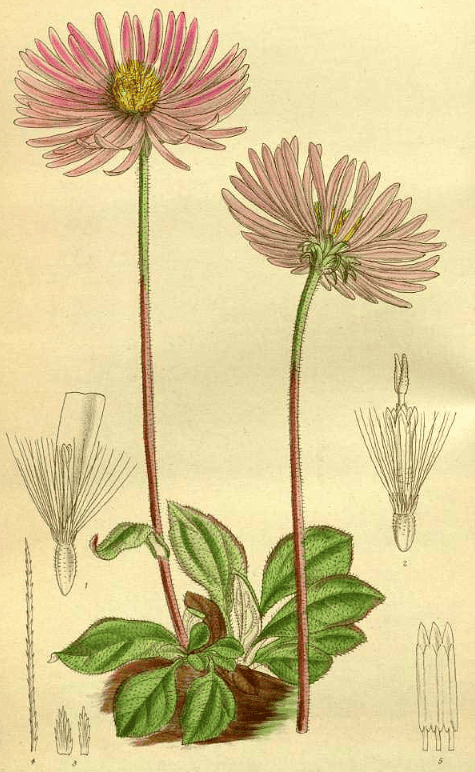Aster himalaicus, Me tog lug mig མེ་ཏོག་ལུག་མིག
Alpine AsterMe tog lug mig, Chu De Wa (Tibetan)
 Aster flaccidus
Aster flaccidusCurtis’s Botanical Magazine, (1913)
 Aster himalaicus
Aster himalaicus(Photo by Krzysztof Ziarnek) (Wikimedia)
Botanical name:
Aster spp.
Several species have been listed as a source of Me tog lug mig:
- A. himalaicus
- A. souliei
- Ser Po (Yellow-flowered)
- Nag Po (Black-flowered)
- Sngon Po (Blue-flowered)
- A. barbellatus
- A. flaccidus (syn. A. tibeticus, A. argunensis, A. glandulosus, A. heterochaeta, A. intermedius, A. pulchellus, A. purdomii)
- A. heolini
- A. alpinas
- A. diplostephioides (syn. A. delavayi, A. vilmorinii, Heterochaeta diplostephioides)
- A. thomsonii (syn. A. flexuosus, Calimeris flexuosus)
Parts used:
Flower; Whole herb
Temperature & Taste:
Cool, dry. Bitter
Uses:
1. Clears Wind-Heat, Resists Poison:
-Common Cold, Fever, Epidemic Fevers
-used against Poisoning
2. Clears Heat, Stops Cough:
-Cough, Chronic Bronchitis
-can be used for any type of Cough depending on the herbs its combined with
3. Externally:
-topically for Psoriasis
-spasms of the Tendons and Ligaments
-applied to dry blood and pus in Wounds
-in baths for ‘Brain (Wind) diseases’
Dose:
Powder: 1–3 grams
Substitute:
For Cough, the Chinese Aster Zi Wan can be considered. It may, in fact, be a suitable substitute for all indications.
Main Combinations:
1. Cough and Fever, Aster Me tog lug mig with Azadirachta indica, Swertia, Pomegranate seed, Gentiana algida flower, Dandelion
Major Formulas:
Cautions:
None noted
Main Preparations used:
Click the Tabs above for more information on this Medicin
1. Eudesmane sesquiterpenes and other constituents from Aster himalaicus.
2. Modulation of diverse oncogenic signaling pathways by oroxylin A: An important strategy for both cancer prevention and treatment.
3. 5,6-Dihydroxy-3,7,’-trimethoxyflavonol induces G2/M cell cycle arrest and apoptosis in human hepatocellular carcinoma cells.
4. 1-Oxoeudesm-11(13)-eno-12,8a-lactone induces G2/M arrest and apoptosis of human glioblastoma cells in vitro.
5. 1-oxoeudesm-11(13)-ene-12,8α-lactone-induced apoptosis via ROS generation and mitochondria activation in MCF-7 cells.
